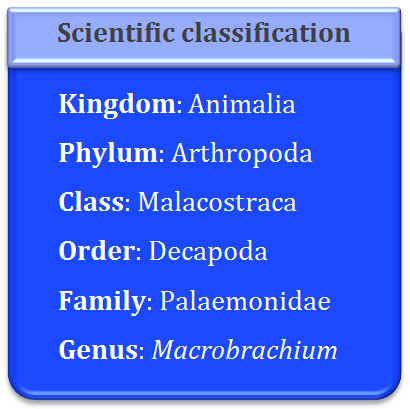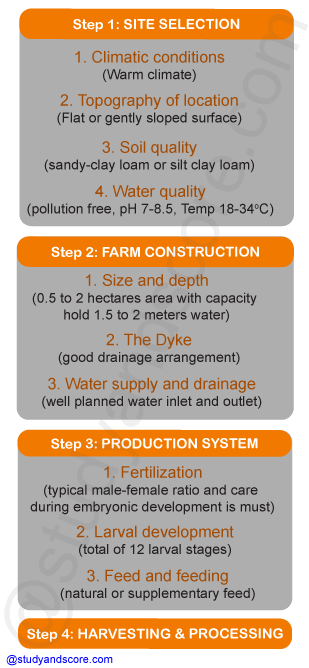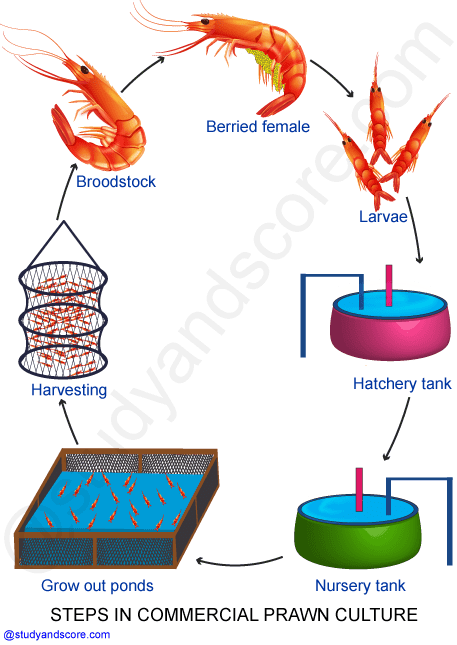
In India, aquaculture has evolved from just a backyard activity to an activity driven by technology and a commercial business. Currently, India stands second in world aquaculture production next to China. The following are the features which played a major role in lifting the face of in India in commercial aquaculture:
In India large scale farming of Macrobrachium rosenbergii is very popular. It is commonly called "Scampi". It has high demand in both domestic and international markets.
History of Prawn culture
Early attempts of prawn culture by stocking ponds with juvenile prawns had disappointing results. Also experiments carried out by several Asian countries on prawn culture under controlled environment were unfruitful. In 1961, a breakthrough was made by Marine fisheries Research institute, Malaysia. They discovered that certain amount for salinity was important and basic requirement for the survival and development of the early stages of Macrobrachium rosenbergii larvae.
Currently, Macrobrachium rosenbergii is the favorite species of Indian prawn culture. In India, Prawn Breeding unit of Central Inland Fisheries Research institutes developed indigenous technology for prawn culture in the year 1975.
Identifying features of Macrobrachium rosenbergii
Macrobrachium rosenbergii is also known as Giant fresh water prawn. The following are the identification features of this prawn:
Species of Prawns for culture
In India a total of 34 species of Macrobrachium comprising of 20 fresh water species and 14 coastal water species have been reported. Out of these only two species are utilized in monoculture and polyculture practices owing to their large size, fast growth and shorter life history. These two species are,
Distribution of Macrobrachium rosenbergii
Macrobrachium rosenbergii is mainly confined to Fresh water and brackish water habitats. They are sometimes also found in marine waters. It is mostly distributed in Indo-west pacific regions including India, Vietnam, Philippines, New Guinea and northern Australia. In India, Macrobrachium rosenbergii is also known as Golda chingri and Mocha chingri.
The technical requirements for establishment of fresh water prawn farm and its successful operation are briefly described below:

Step 1: Site selection
Careful selection of suitable site for fresh water prawn farming is an essential prerequisite for successful farming operation. The site selection plays an important role as the entire management aspect of the farm ultimately depends on specific conditions of the site. The aspects to be considered for site selection are as follows:
Climatic conditions: Warm climate is the most important factor affecting prawn production. Tropical and sub-tropical climates are most suitable when the culture period is too long while warm temperate climate is suitable where culture period is short. Also other climatic conditions like rainfall, evaporation, sunlight, wind speed etc. also play a critical role.
Topography of the location: The ideal site must be flat or gently sloped. Low-lying lands, waterlogged areas, salinity and alkalinity affected areas could be effectively used for construction of Scampi farms.
Soil Quality: The soil texture must be sandy-clay loam or silt clay loam with at least 85% water retention capacity. The clay content in the soil should not exceed 60%. Acid sulphate soils should be avoided for freshwater prawn farming.
Water Quality: The availability of quality and quantity of water is a critical factor. Moreover water should be free from pollution. The pH of water should be of 7.0 to 8.5. The water temperature should range from 18°C to 34°C. Dissolved oxygen content of water should be 3 to 7 ppm.
Step 2: Farm Construction
After fulfilling all the suitable site location requirements, the next step is the construction of farm. The design must suit the operational convenience and biological necessities of the prawn.
Size and depth: For operational convenience a minimum area of one hectare is widely accepted size of the farm. Depending on the local conditions the size may vary between half to 5 hectares. Though square farm is more economical, rectangular farms are more suitable for the harvesting. The constructed pond should have the capacity to hold at least 1.5 to 2 metre water inside.
The dyke: The bottom of ponds needs to be sloped towards the drainage point or dyke. The drainage system should be designed carefully to prevent mixing of outlet water with incoming water.
Water supply and Drainage: Appropriate water supply and drainage systems have to be designed keeping in view the water source. The ponds should be easy to drain out the water. Ground water is preferable for filling the ponds as it is free from pollution. When using canal water, it should be made free from pollution. Care should be taken to provide adequate micro filters for removing the eggs and larvae of fishes especially of omnipresent Tilapia.

Step 3: Production system
Female brood stock is usually obtained from grow-out ponds or from capture fisheries. Normally, "berried" or egg-carrying females are used only once.
Fertilization: A typical male to female ratio is maintained in brood stock holding systems. Within a few hours of copulation, external fertilization occurs and the eggs are transferred to the brood chamber beneath the abdomen of the female. Eggs are orange until 2-3 days before hatching and just before hatching, they become grey-black. The eggs remain attached to the female during embryonic development. At hatching, free-swimming zoeae are produced.
Larval development: First stage zoeae are very small in size about 2mm and grow through 11 larval stages, to almost 8 mm at metamorphosis into post larval forms. Individual metamorphosis can be achieved in 16 days but usually takes much longer, depending on environmental conditions.
Feed and feeding: Feed management plays a very crucial role in prawn culture. More over natural food is preferred over supplementary food. But due to lack of natural food and to increase the growth and quality of production supplementary food is used.
Supplementary food include agricultural and animal husbandry by-products along with locally available cheap feeds like broken rice, tapioca root, trash fish, vegetable and animal feeds mixed in adequate proportions. The feed is produced in pellet form, which should sink in water quickly and should be intact for at least few hours till they are completely consumed by the prawns.
Prawns are generally fed only once a day. Food pellets are distributed uniformly on the surface of the pond or placed in wide containers set up at several points along the margin of the pond. The rate of feeding depends on the age of the prawns.
Step 4: Harvesting and processing
Pond reared giant prawns reach marketable size within 5-8 months depending on the stocking rate and other culture conditions. Generally, giant prawns do not grow at uniform rate and difference in size appears in spite of stocking the seed from same brood. Hence size for harvest must be checked from time to time.
Harvesting can be done partially of completely. Partial harvesting is done for removing larger prawns from the pond at regular intervals. For partial harvesting nets are specially designed to capture only large prawns and exclude smaller ones.
In complete harvesting prawns are harvested by draining the ponds. Draining is done in early mornings to avoid overheating of water when only little water is left in the pond. In the final stage when the prawns are near the outlet they must be provided with fresh oxygenated water.
Careful handling is essential during harvesting to ensure good quality products. Freshwater prawns tend to go "mushy" if not handled and processed correctly.
Firstly, it is essential to prevent prawns from becoming crushed during harvesting.
Secondly, if they are not going to be sold live, they should be killed in a mixture of water and ice at 0°C immediately after harvesting and washed in chlorinated tap water. Prawns for live sale can be transported in aerated water at 20-22°C. Prawns sold fresh must not be kept on ice for more than 3 days. Prawns for frozen sale must be quickly frozen at -10°C and stored at -20°C or below.

- Share with your friends! -
Login to post your comment here...
- or with social Account -